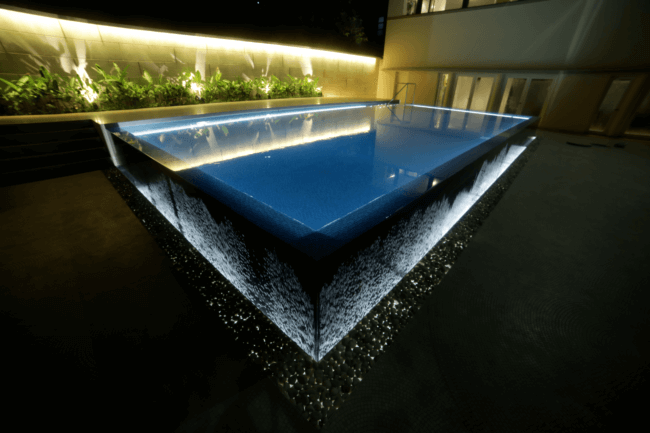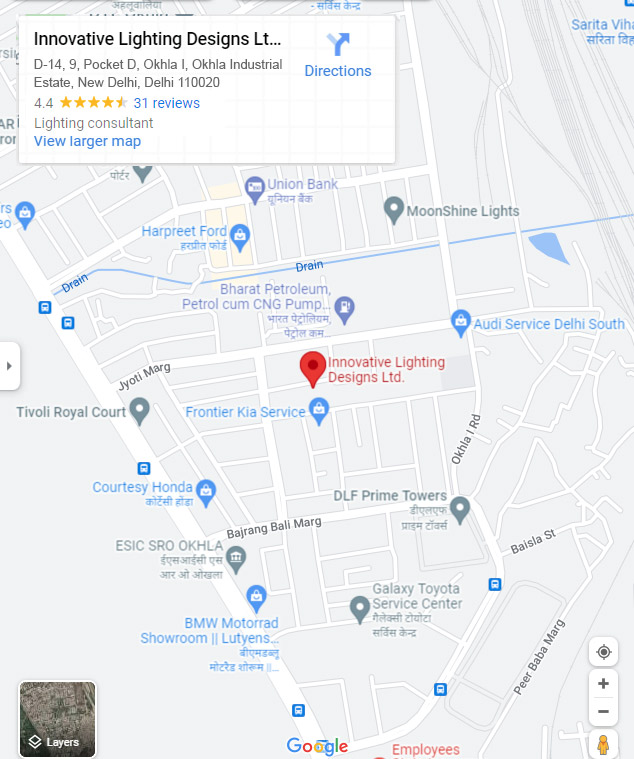Glossary
In a device with rotational or X-Y symmetry, twice the angle between the maximum intensity equal to half of the maximum.
Approximate agreement between the result of a measurement and the actual value of the item being measured. It is a qualitative term the term “precision” should not be used as a synonym.
System composed of one or more radiators made of a conductive materials, plus a fan or another element conveying air on the radiator.
Adjustable, removable partitions applied on a projector, able to screen its light as required.
The Sl base unit used to measure the intensity of electric current.
Angle of inclination calculated upward from the horizontal of a lighting fixture.
Element usually with square of hexagonal grid (other geometric shapes could be applied) able to cut unrequired, dazzling light rays that can cause glare. Its finish is usually black or aluminium. The shaped section allows the reflected light to be deviated towards specific angles, so that the dazzle effect is removed. Asymmetric lens shield tube Accessory Located in front of a projector, able to cut unrequired, dazzling light rays that can cause glare.
Lighting intensity emitted by any lighting Device on its own main axis.
Part of the emergency lighting provided To ensure that an exit can be identified efficiently and used if the normal lighting System does not work.
In a projector, or in a rotosymmetrical / X-Y type device, it is double the angle made by the direction of the axial luminous intensity and the direction where intensity is ½ of the axial.
A term used in the LED industry to define selections of : Colour (the BIN defines a variable area of the chromaticity diagram). Luminous Flux (the BIN define the amount of luminous flux emitted). Vf (the BIN specifies the maximum and minimum values of the voltage drop applied across the LED terminal).
It is an ideal object absorbing all incident electromagnetic radiations. Being black it is neither reflecting nor transmitting any energy. The black body produces electromagnetic as a consequence of its temperature.
Sl unit of luminous intensity the canadela (cd) is the luminous intensity, in a given direction of a light source that emits monochromatic radiation at a frequency of 540 THz and whose energy intensity in that direction is equal to 1/683 W per steradian.
Sl unit of luminuance.
Optical system usaually mixed (refractive + reflective) on which reflection takes place, both because of the TIR principle and because of the use of mirrors.
Acronym of Correlated Color Temperature. It is expressed by the colour temperature in Kelvin degrees of a specific colour while in proximity of the black body curve in the different chromatic diagrams.
Measurement unit of the luminous intensity. It is expressed in candles and is referred to the luminous flux installed. expressed In Kilo lumens.
Index evaluated by the ability to render a series of 14 colours, chosen using Munsell chromatic system, compared to a reference source depending on the colour temperature. If the colour temperature is below 5,000K the reference source is the black body spectrum with the same colour temperature. If the CRI is higher, then the chosen reference source is a series D illuminant with colour temperature similar to the one of the source chosen.
Plane diagram in which the points, defined by the respective trichromatic coordinates, represent the chromaticity of colour stimuli.
White colour of a light source with colour temperature greater than 5000 Kelvin.
A lens directing the light rays incident on itself to the parallel optical axis of the lens itself.
It is the temperature of the black body producing a spectral emission with chromatic features similar to the source itself. The colours emitted by heating the black body are, starting from the lowest temperatures, red (up to 1,800K), orange (between 1,800 and 2,200K), warm white (between 2,200 and 3,500K), neutral white (between 3,500 and 5,000K), cold white (from 5,000K to infinity).
Color difference inside a chromatic section of a lighting source (e.g. LED), usually produced by the manufacturer and identified with an acronym.
Measurement of colours, based on a set of conventions.
Photoreceptors of the retina containing Pigments that are flexible in light which are the basis of the photopic vision process.
Connecting element between two components of a system. It can be mechanical, electrical or electronic.
See also definition of ‘current’. Current supplied by an electrical device that is kept at a constant level. Constant current power supplies distribute a specific current within certain tension limits. These can vary from zero to a maximum value, or from a minimum to a maximum value.
See also definition of ‘tension’. Tension supplied by an electrical device, Kept at a constant level until its maximum power level is reached.
Subjective adjustment of the difference in Appearance of two parts of a visual field (observed simultaneously or in succession).
Electrical charge flux (usually negative) passing through a surface during a time unit. It is a fundamental magnitude in the Internation- al System. It is measured in Ampere.
In a photometric solid, it is the angle or the angles in which a net distinction between light and dark can be perceived. It is calculated in respect to the main axisof The device.
Digital Addressable Lighting Interface. Protocol managing a system of light fittings Through a signal transmitted by a single pair of wire. The DALI system can manage single or groups of light fittings included in the system. Also it can switch on and off and create scenaries with light fitting belonging to a same system.
Compactibility of the power supply to work on a DALI protocol only or also through the SwitchDim function. In this last case. the load dimming is made through a simple push-to-make switch at the supply voltage.
Device showing a luminance lower than 3,000 cd/m2 in every ‘C’ plan for ‘gamma’ values equal or higher than 65°. It is calculated in respect to the main axis of the device. This value was originally 1,000 cd/m2 now it is increased to 3,000 cd/m2 for most devices.
Light design software. Used to obtain all types of lighting calculations and related documentation in accordance with the legal regulations in forcein various countries, as well as visualizations and animations for a realistic rendering of a project.
Element modulating the amount of luminous flux passing through an optic system. A so called ‘vignetting’ phenomenon takes place if opening s of other elements interfear with the above.
Deviation of the direction of propagation of radiation, determined by its wave nature which occurs when the waves are restricted by obstacles.
Lighting in which the light on the work surface or on an object does not come from any particular direction.
Optical element, transparent or opaque, able to diffuse its incident light rays in the surrounding space.
Phenomenon whereby the spatial distribution of a beam of radiation changes when the beam is deflected in multiple directions by a surface or a medium, without changes of frequency in its monochromatic components.
Light fitting that can adjust their light intensity.
Glare produced by light source in the visual field.
Lighting by devices that distribute the light intensity in such a way that 90-100% of the luminous flux goes directly onto the work surface, assuming that this surface is not infinite.
The while light that falls on the face of a prism, is dispersed and flows out from the opposite face with the spectral components separated. This occurs because the index of refraction of a given material is a function of wavelength and therefore different colours (different wavelengths) are refracted at different angles.
DMX512, often abbreviated DMX (Digital Multiplex) is a communications protocol used mainly to control scene lighting [and] for control from computers or central units of complex lighting systems with moving or conventional lights. Each DMX512 cable can transmit up to 512 8-bit values between 0 and 255, so that a cable can control up to 512 separate devices. Since DMX only supports 512 channels, there may be situations where separate DMX universes are needed. A DMX universe is a single line connecting the controller and all the devices associated with that cable. Most recent DMX consoles support more than one DMX universe each of which must be wired independently. A DMX cable is made up of at least three poles for the transmission of signals.
Device with direct emission, generally mounted in plasterboard ceilings. It is used in corridors (where no glare control is needed) and in workplaces (where conformity to standard UNIT12464 with regard to direct glare and glare on video terminals must be ensured). They are usually installed in the lights arespaced evenly at 1.8 x 1.8 meters or 2.4 x 2.4 meters.
Ratio between the luminous flux of a lighting device and its power in watts. It is expressed in lumen/W.
Optical output percentage ratio between the output the luminous flux of the light fitting and the flux emitted by the light source. (See LOR)
An electrical connector such as an electrical omponent, or an area of a printed circuit board, whose function is to electrically connect two or more electrical components exclusively by means of operations of a mechanical type (therefore without requiring electric welding).
Power supply system with voltage or low tension. Electrical conductors are located inside the track.
Electromagnetic energy carrier in single packs or ‘quantums’ of energy of energy, with a defined energy value. It moves in a straight line at approximate 300,000 Km/s. it has associated magnetic and electrical fields varying in time following a sine law.
Ellipsoidal mirror (rotational or not) that, with a light source on the first focus, can replicate its image on the second focus (if rotational ellipsoid) or on a specific area of the optical axis (if non rotational ellipsoid).
Lighting intended for use when a general lighting system fails due to a power failure.
See Beam.
Standard that defines lighting technology features such as average illumination, uniformity, colour rendering and UGR for interiors. This standard also defines the maximum luminance of a device to be used in environments where there are video terminals.
Of the eye or eyes. Angular width of the space in which an object can be when the observer looks at an object directly in front of him. The field can be monocular or binocular.
Optic element that can totally or partially select the wave lengths of a light source spectrum. In case of a total selection (net cut of the wave lengths between certain values), it is called a bandpass filter.
Term to identify a 2 ½ theta opening between 15 and 20° in a projector.
Discharge lamp of the low pressure mercury type in which most of the light is emitted by a layer of fluorescent material excited by the ultraviolet radiation of the discharge.
Element allowing construction of large optic and small focal distance without the obstruction, the thickness and the weight of the material used to produced a spheric conventional lens of equivalent diottric power. The result is obtained dividing the spheric lens into a series of concentric circular sections, called Fresnel rings. For each zone the thickness of the lens is limited, while the continuous curve is transformed into a series of surfaces of non-continuous with the same curvature.
Essentially uniform lighting of an area or a volume that does not take into account specific local needs.
Visual condition in which there is discomfort or reduction of vision, caused by an unsuitable distribution or degree of brightness or too much contrast in space and time.
Instrument for the measurement of photometric magnitudes, for measuring the angular distribution of a magnitude of brightness emitted by a light source, a lighting fixture, a medium or a surface.
Lamp containing a tungsten filament and a small amount of one or more halogen gases for the purposes of cyclic regeneration of the filament.
Optical system in which both mirrors and lenses are used. More generally both reflective and refractive elements are employed.
Measurement of the variation of illuminance on the place concerned , expressed as ; ratio between the minimum and maximum illuminance; ratio between the minimum and average illuminance.
Photometric value showing the quantity of luminous flux for surface area. Common measurement units are lux (lumen/m2) used in the international system, and foot-candle (lumen/ft2) in the United States.
Illumination designed to light an area with greater brightness in specific positions, such as where a very accurate visual task is being carried out.
Lamp in which the light is produced using an element brought to incandescence by the passage of electric current, which emits radiation in the visible range.
Optical radiation having a wavelength greater than those of visible radiation.
Homogeneous grouping defined by the IEC (International Electrotechnical Commission ), Indicating the technical features applicable to an electric device in order to reduce electrical device in order to reduce electrical hazards in case of fault. Class I electrical devices: The protection is based on the mains insulation and on a additional security measures. This is made by the connection of the conducting parts accessible to a protection conductor (protection earthing /grounding system ) falling under the fixed electrical system. Class II electrical devices: Also known as double insulation devices, are manufactured so that the earthing/grounding system is not required. In this case an eventual fault cannot cause the user to come into contact with dangerous electrical tensions. Class III electrical devices: The protection against electrocution is due to the use SELV (Safety Extra-Low Voltage) security tension. The device is operated either by battery or by a SELV transformer.
Abbreviated to “SI System” or sometimes just “SI” this is the set of units of measure agreed on by all countries that have signed the Metre Convention.
International Protection (Or protective class IP) is a source code summing up the level of protection of an electrical appliance in case of accidental or international contact with a human body or with objects, and also the protection against contact with water IPXX; the first digit shows the protection against the contact with solid bodies and the contact with dangerous parts. The second digit shows the protection against the contact with liquids.
Locus of points belonging to a surface at which the light intensity has the same value.
The Kelvin (K) is a unit of measurement of temperature that is one of the seven base units of the international system of units. In lighting , it is the measurement of the colour of light ,see colour temperature.
Ideal surface that reflects the energy coming from one direction equally in all directions and thus its luminance remains the same even if the viewpoint is different, it is therefore an ideal diffusing surface.
Acronym of Light Emmitting Diode. The LED is an electronic device made by the union of two elements composed of semiconductor material (typically silicon). The two elements are “doped” ,meaning that specific materials are added to them so that has mainly negative charges (electrons) and the other one mainly positive charges (holes). The passage of electrical current through the “junction” of the two elements causes the electron-hole recombination to occur, and this produces the phenomenon of the spontaneous emission of light at a given wavelength. The LED is therefore a monochromatic light emitter; white LEDs which through there radiation, excite phosphors which in turn, according to the same phenomenon of spontaneous emission, convert part of the blue radiation into others of the visible spectrum.
Optical element producing convergence or divergence of light rays on itself, thanks to refraction.
See Service Life.
Portion of the electromagnetic waves spectrum that are visible to the human eye.
Transparent optical element transporting light by means of TIR effect , e.g optic fibre.
Acronym for Light Output Ratio. It is percentage value obtained by the ration between the luminous flux of a device and the luminous flux installed.
Screen Whose shielding elements are lamellae made of opaque or translucent material.
SI units of luminous flux. The lumen (Im) is the luminous flux emitted in a unit solid angle by a uniform point source having a luminous intensity of 1 candela.
Generic term to indicate a lighting device. Luminance Photometric value showing the luminous power of a light source for solid angle unit and for surface unit. It is used to define how bright a surface is at a certain angle. In the international system it is measured in candles per square meter (cd/m2), in the United States in foot-Lambert.
Photometric value showing the amount of light emitted by a light source. It comes from the radiant flux(W) and is expressed in lumen.
Photometric value expressing the lighting power of a source for solid angle unit. It is an essential value in the international system; it is used to define how bright a specific point is at a certain angle. It is measured in candles (cd).
SL unit of illuminance Illumination produced on a surface with an area of 1 square meter by luminous flux of 1 lumen uniformly distributed on this surface.
Components (electrical plates, optional extensions, cables and feeding kits) with 3 wire cables (+, ..signal) and 48 Watt feeding tension. Feeding Unit and control interfaces are needed in addition. Generally used for RGB LEDs with exception of Stand Alone versions.
In CEI chromatic diagrams, these are ellipse area defining the ability of the human perceiving colour differences from this centre of the elliptical area. E.g a Step of MacAdam Ellipse means that on average the human eye is able to perceive 3 different colours from the centre to the border of the ellipse.
Ratio, expressed as a percentage between the average illuminance under the same time conditions on an external horizontal surface that receives light from the sky.
Intermediate vision between photopic and scotopic vision.
A light source that produces light, directly or indirectly, by an electric discharge through a gas, a vapour metal or by a part of different gases or vapours.
In a illumination (lux) or luminance (cd/m2) Map, it is the ratio between the lower and average value observed.
Radiation characterized by a single wavelength. By extension, radiation characterized by a light waveband so limited that it can be defined by the indication of a single wavelength.
Electromagnetic radiation in which the energy is concentrated in single wavelength. Strictly speaking, monochromatic spectra are only emitted by lasers, but in reality those emitted by LEDs are also defined as monochromatic radiations, even if they are not exactly so.
Optical system made of more lenses, used to make very precise projections. MV(Medium Voltage); components (electrified plates, optional extensions, cables and feeding kits) with 7 wire cables (Neutral, direct line, Indirect line, Auxiliary line, Earth, DALI 1 and DALI 2) and 230 VAC feeding tension, if dimming is required an external DALI circuit complete with DALI power supply , group controller and scene controller is needed. Used for feeding and dimming iluorescent lamps, white LEDA spot groups and RGB Stand Alone LED versions.
Components (electrified plates, optional extensions, cables and feeding kits) with 7-wire cables (Neutral, Direct Line, Indirect Line, Auxiliary line, Earth , DALI1 and DALI2) and 230 VAC feeding tension. If dimming is required an external DALI circuit complete with DALI power supply group controller and scene controller is needed . Used for feeding and dimming fluorescent lamps, white LEDs, spot groups and RGB Stand Alone LED versions.
See Tunable White
White colour of a light source with a colour temperature between 3500 and 5000 Kelvin.
In physics, Ohm’s Law, whose name comes from the German physicist Geong Simon Ohm, express the constitutive law of proportionality between the electric potential difference across a conductor and the intensity of the electric current passing through it. The constant of proportionally is the electrical resistance. Denoting the electric potential difference at the terminals of an electrical conductor with V, and the electric current passing through it with I, Ohm’s law states that V=RI, where R is the electrical resistance characteristic of the conductor. It is a constant, regardless of the value of the current. The current comprises an ordered movement of electrons, driven by an electric field, which have kinetic energy. The work done on them by the field in the unit of time is given by the power, when the flow of charges passes through a resistor part of all of the kinetic energy of the charges is transferred to the material. This is the phenomenon is called the joule effect , and the power transferred to the material is given by; P (W) = V(v). I(A).
Electromagnetic radiation having a wavelength between the X-Ray transition region(-=1 mm) and the radio waves transition region(-=1 mm).
Part of physics that studies the phenomena connected with emission, propagation and detection of light.
System Composed of one or more radiators making sure that a light source (usually LED) is working at an adequate temperature. This system is based entirely on the shape and mass of the radiators.
Spatial representation of the light intensity radiated by any lighting body.
From Greek FOTOS (light) and METRIA (measurement). Branch of physics studying the measurement of photometric values. These are related to the portion of electromagnetic waves spectrum that are visible to the human eye. Photometric values are obtained by radiometric values through integration of the radiometric spectrum, calculated on the photopic V curve (lambda) multiplied by 683.
From the Greek “ Phos, Photos” which means light, the photon or quantum of light is the elementary particle of energy making up electromagnetic radiation.
Vision that occurs when the eye adapts to luminance levels greater than 3-4 candle as per square meter .The cones are considered the man active elements of vision in these conditions.
Planck’s law is a law of physics devised by German Physical Max Planck, starting that The energy associated with electromagnetic Radiation is transmitted in indivisible packets Called quanta, each of which is associated With a single photon.
Accornym for Poly Methy Main Accrylate in Plastic material with transparency and appearance very similar to those of glass :It was initially marketed by German company Rohn Under the trade name “Flexiglass”. It is widely used in the automotive sector Clear lamp covers of cars and motocycle and In lighting.
Plastic Material with excellent properties of Mechanical resistance, especially to bending . It is used instead of glass or PMMA, where Good impact resistance and good flexibility are required. It is sensitive to ultraviolet light Which is Why it is often treated with point that can later the rays.
The power is defined as the work(W) performed in a unit of time(T). According to the principle of equality between work and energy power measures the amount of energy exchanged in the unit of time, In any transformation process ,Whether this is mechanical ,electrical, thermal or chemical measured in watts(W).
A power supply is an electrical device that changes the output electrical tension from AC alternate to DC continuous .The electrical power can be adapted in this way So that other electrical equipment can be used through a transformer , the level of output tension and current, and therefore power, are modified.
Elements that are first intercepted by light in an Optical system.
Projection with optic elements able to‘shape’ the projection, Obtaining a net distinction between light and dark in the projected light profile.
Optic device able to transfer the lighting energy from a source to a projection plan. The transfer can be made replicating the image such as in cinema projectors (imaging optic)or without replicating the image such as in the illuminators (non imaging optic).
Energy emitted, transferred or received as radiation. Measured in joule, j=W.S
Emission or transportation of energy in the form of electromagnetic waves or particles.
From latin RADIUS (ray) and greek METRIA (measurement). Branch of physics studying measurement of radiometric magnitudes related to electromagnetic energy , such as radiating flux (W).radiating energy , such as radiating intensity (W*sr-1*m-2).
Ratio between the luminous flux reflected by a surface and the luminous flux incident on the surface.
Physical phenomenon that occurs when a ray of light projects onto a mirror surface. The angle between the incident ray and the perpendicular to the incident point are equal to the angle between the reflected ray and the perpendicular to the incident point.
Screen in which the shielding depends mainly on the phenomenon of refraction.
Optic element able to reflect light. This term includes all elements treated with vacuum-sealed aluminum and producing a secular surface. It is a fact through that also all opaque elements are to some extent reflectors.
Physical phenomenon that occurs when a ray of light projects onto a border between two mediums with a different refraction index (or with two different densities).The refraction law, also known as Snell law is defined as follows: n*sen(i)=n’* sen(i) n and n’ are refraction indexes of the first and second medium; “I” and “ I ‘ “ are the angles relative to the perpendicular of, respectively , the incident ray and the refracted ray.
Infrared remote control for light management.
Light source using an advanced technology replacing an obsolete one with the same mechanical features.
Optical device designed to deflect the rays that fall on it towards the source of the light .The rays undergo two refractions and a reflection in variously shaped elements.
Acronym for RED-GREEN-BLUE, used to identify systems with multicolored light sources which , through additive synthesis, can create all the colours of the visible range and their possible combinations , including white.
Photoreceptors of the retina in which pigments are sensitive to scotopic vision. Rods are considered not to play any role in the discrimination of colour stimuli.
Attribute of a visual sensation that allows you to judge the proportion of pure chromatic colour in the total sensation.
Vision that occurs when the eye adapts to luminance levels less than a few hundredths of a candela per square meter; the rods are considered the main active components of the eye in this condition. The spectrum appears not coloured.
Part of a lighting device consisting of translucent or opaque elements, geometrically arranged in such a way as to hide the lights from the observer at certain angles.
In an optical system, these are elements that are intercepted by light in the second place.LED power supplies are created especially for the piloting of LED load.There are two main groups: the constant current power supplies regulate directly the current of the LED load , While the constant tension power supplies create a continuous tension through which other devices controlling LED loads can be operated.
Part of the emergency lighting system designed to ensure the safety of persons.
Quotient between the response Y of a detector and its excitation X.
Time period from the first time a light source is switched on and a specific percentage of its estimated life span (e.g.70%) LED manufacturers estimate the life cycle through tests lasting less than its determined life span. E.g L70(6KL)>36,000 hours means that the light source will produce a luminous flux higher than 70% of its initial luminous flux after 36,000 hours. Also this estimate was performed through a test of 6,000 hours.
Solid Angle subtended at the centre of a sphere by cap with an area that is numerically equal to the square of the radius , Measured in steradian , sr.
Any element able to product an electromagnetic radiation.
Distribution of a radiometric magnitude (radiance, radiation intensity, radiating flux),as a function of radiations frequency or wave length.
Standard regarding electrical safety of lighting devices.
Standard regulating photo biological perspective of the usage of LED sources. Steradian (sr)SL unit derived from a solid angle which, having Its vertax in the centre of a sphere, cuts an area of the spherical surface equal to that of a square having the radius of the sphere as its side.
SL unit derived from a solid angle which, having its vertex in the centre of a sphere, cuts an area of the spherical surface equal to that of a square having the radius of the sphere as its side.
Latest generation calculation tool used to come up with lighting and system control solutions to ensure a targeted use of energy resources, starting from regular estimates of the costs of installing and operating the equipment.
Difference between the electric potential between two points in space, caused by their electrical power.
Management of the thermic dissipation of a light fitting , usually LED.
Emission process in which the radiant energy has its origin in the thermal agitation of the particles making up the matter (atoms, molecules, ions)
Optical element that, associated with an LED, Works as a parabolic reflector using the total reflection principle.TIR is the acronym for total internal Reflection.
Electrical device used to transform input and output electrical power parameters (tension, current intensity) , maintaining constants electrical power. The transformer is a device that can be operated in alternate current, thanks to the electromagnetic principles linked to variable fluxes.
Light source able to create different tones of white light, going from warm (2,500K) to cold white (6,500K). It can be made of white or coloured sources. Neutral White: White light with neutral colour temperature (3,500-5,000K). Warm White: White light with warm colour temperature (2,500-3,500K). Cool White: White light with cold colour temperature (5,000-10,000K).
Unigied Glare Ratio, Parameter expressing the glare of a light fitting , through the evaluation of its luminance.
Optical radiation with wavelengths shorter than those of visible radiation. In the range between 100 and 400 nm, ultraviolet radiation is generally indicated with the symbols UVA between 315 and 400 nm, UVB between 280 and 315 nm and UVC between 100 and 280 nm.
UNI Standard that establishes the lighting technology parameters related to workstations. The standard defines characteristics such as : Minimum illumination , uniformity , colour rendering of sources and UGR for various workplaces.
Term to identify a 2 ½ theta opening greater than 30° in a projector.
Optical Radiation that directly causes a visual sensation. Even if the range of wavelengths concerned in vision depends on the individual and on the illuminance on the retina, the lower limit is normally indicated between 360 nm and 400 nm and the upper limit between 760 nm and 830 nm.
Degree of effectiveness of the visual system, measured for example by the speed and accuracy with which a visual task is accomplished.
Set of elements of the work performed.
Voltage Drop (Vf) is a synonym of the potential difference. More specifically if a resistor of resistance R is inserted between two points A and of an electrical circuit and traversed by a current of intensity I, Ohm’s law study that the electric potential at A is greater than B in a quantity equal to R-i. In other words, between A and B there is a potential difference, or voltage drop equal to ΔV = R.I.
Luminaire designed to illuminate the walls of the buildings, whether external or internal; wall washers cannot be with white light or RGB, they are very frequently used to create spectacular effects outside.
White colour of a light source with a colour temperature between 2700 kelvin and 3500 kelvin.
Distance between two successive points, in the direction of propagative of a periodic wave, in which the oscillation has the same phase. Measured in meters (m)and nano meters (nm).
Term to identify a 2 ½ theta opening between 20 and 30° in a projector.
Theta – In a photometric solid with rotational or X-Y symmetry, the angle between the intensity vector with half the maximum value of the solid and a second intensity vector also with half the maximum value, but whose position is a mirror image of the first vector.
In a photometric solid with rotational symmetry or XY symmetry, the angle between the maximum intensity vector of the solid and a second intensity vector with half the maximum value.









